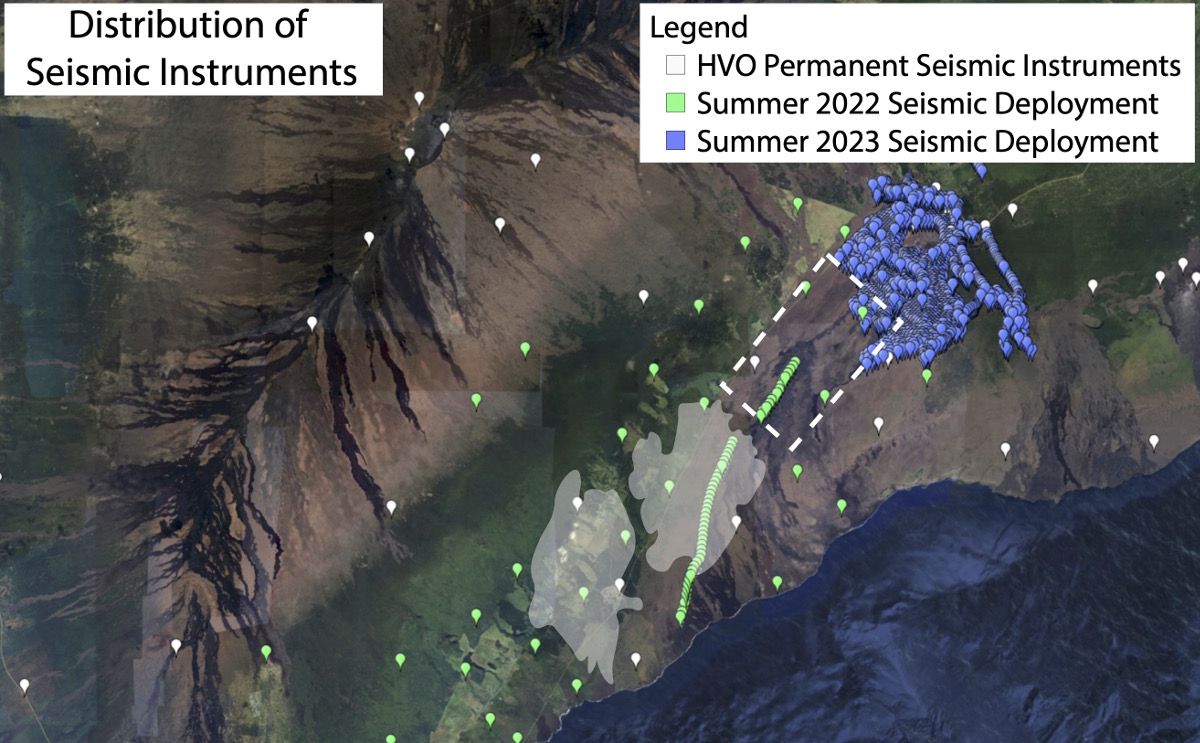(BIVN) – This week’s Volcano Watch article, written by U.S. Geological Survey Hawaiian Volcano Observatory scientists and affiliates, updates what is known about the ongoing deep Pāhala earthquake swarm.
From the Volcano Watch article:
Pāhala, a town located in the southeast part of the Island of Hawai‘i, lies above the state’s most seismically active area. In the last 5 years, the average weekly number of earthquakes has increased from about 60 to 600 earthquakes per week.
These frequent earthquakes occur deep beneath the Pāhala region at approximately 20 to 40 km (12 to 25 miles) depth. Larger events are regularly felt by residents living both within Pāhala and across the island.
In a 2015 study, scientists at USGS located and classified earthquakes in this region into two main groups.
A more continuous seismic tremor, a type of signal often used to trace the movement of magma within a volcanic system, was identified at approximately 40 km (25 miles) depth, both on- and off-shore of the Pāhala region. This activity was interpreted as the migration of magma from the deep Hawaiian hot spot to more shallow depths.
Above this deep region of seismic activity, a zone of volcano-tectonic (VT) earthquakes (indicative of rock breaking) was observed extending from this tremor region to deep beneath Kīlauea. Based on the linear trend of this seismicity, USGS scientists suggested that this distribution of earthquakes marked a path of magma migration underground from storage below Pāhala towards Kīlauea summit. However, evidence supporting this hypothesis was limited to one chain of VT events.
A recently released study by seismologists at the California Institute of Technology (CalTech) sheds new light on the processes occurring deep beneath Pāhala. These scientists have employed newly developed machine learning (computer systems that analyze large data sets and identify major patterns within the data) to identify a large number of extremely small earthquakes (microseismicity) occurring beneath the Pāhala region that were previously uncatalogued by the Hawaiian Volcano Observatory. Such microseismicity is too small to be identified using automated methods typically employed to detect earthquakes.
Many of these events are VT earthquakes located within the zone of deep Pāhala seismicity previously identified by USGS scientists. This large number of newly identified VT events outline what appears to be a region of horizontally layered magma storage deep beneath Pāhala, called a sill complex.
Further supporting this idea, long period earthquakes (indicative of the movement of fluids such as magma) are seen occurring within these sills. Together, these observations demonstrate that deep seismicity beneath Pāhala is consistent with the migration and storage of magma within this sill complex.
The CalTech study also identified a limited number of VT events extending from the sill complex into the region of magma storage beneath Kīlauea summit. The authors suggested that this distribution of earthquakes may represent a possible magma pathway from the deep Pāhala sill complex into Kīlauea’s magma storage reservoir. However, more evidence is needed to support or refute this hypothesis.
The Hawaiian Volcano Observatory (HVO) is undertaking two large seismic experiments in the region to better understand seismic and volcanic activity in the Pāhala and Kīlauea regions. In the summer of 2022, 86 temporary seismic instruments were deployed across Pāhala to record earthquakes occurring within this region for three months. In the summer of 2023, approximately 1600 temporary seismic instruments are proposed to be deployed across Kīlauea summit to record seismic signals for six weeks.
These dense, temporary deployments will record seismic activity across the Kīlauea and Pāhala regions more accurately than HVO’s permanent network of instruments. Seismologists at HVO will analyze these seismic data to understand whether magma stored within Pāhala’s active sill complex is connected to, and therefore a source of magma for Kīlauea volcano.


by Big Island Video News9:26 am
on at
STORY SUMMARY
HAWAIʻI ISLAND - A recently released study by seismologists has shed light on the mysterious magmatic processes occurring deep beneath Kaʻū.